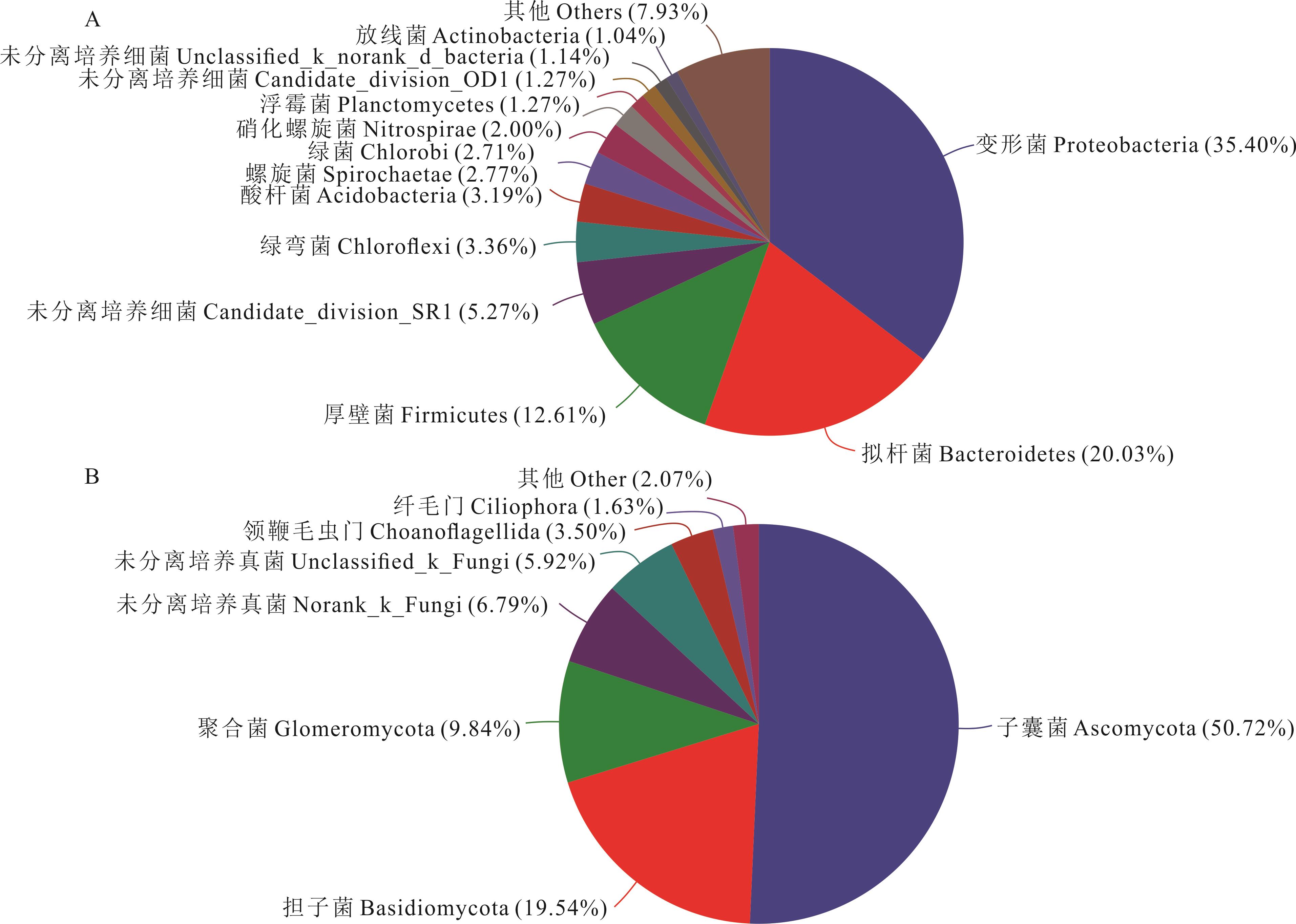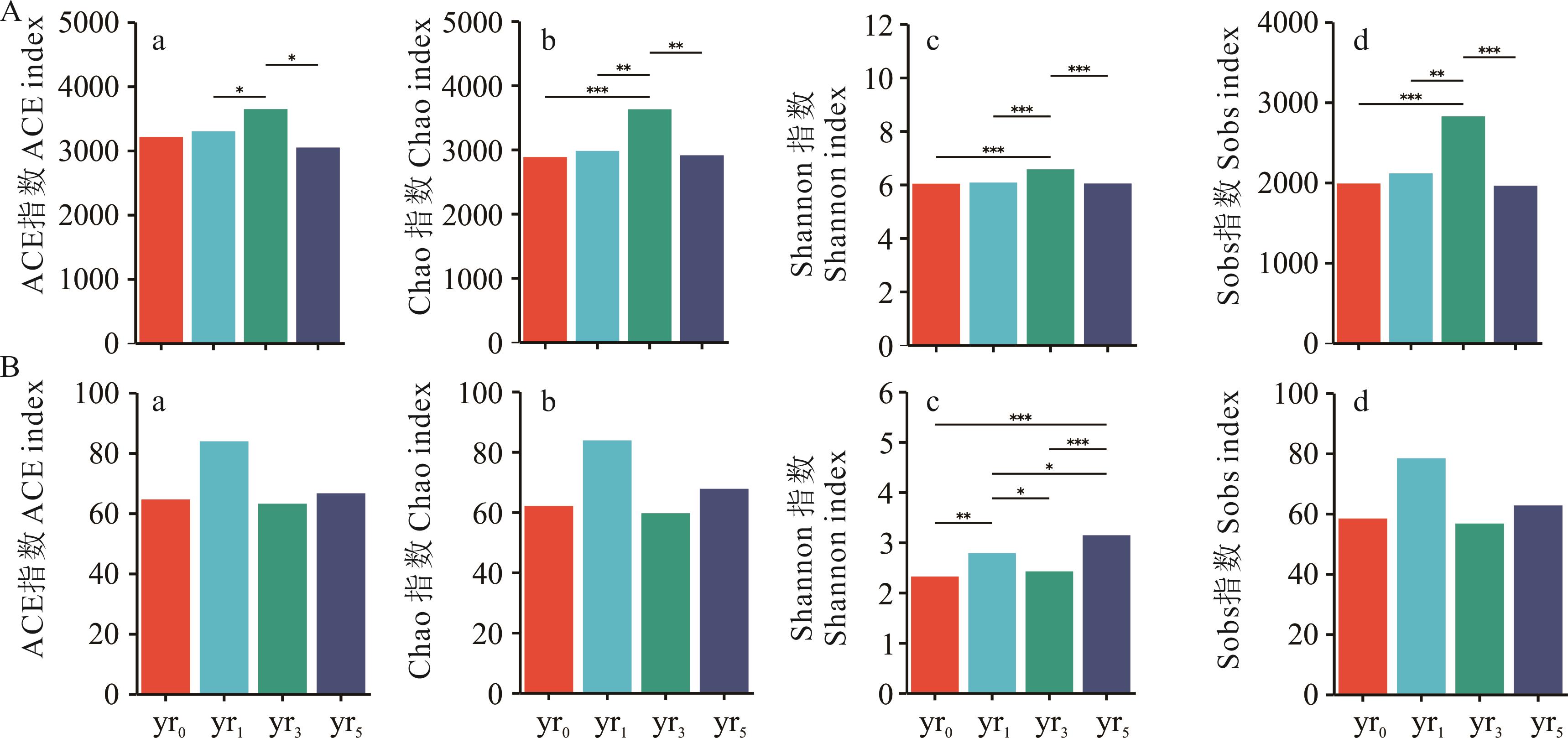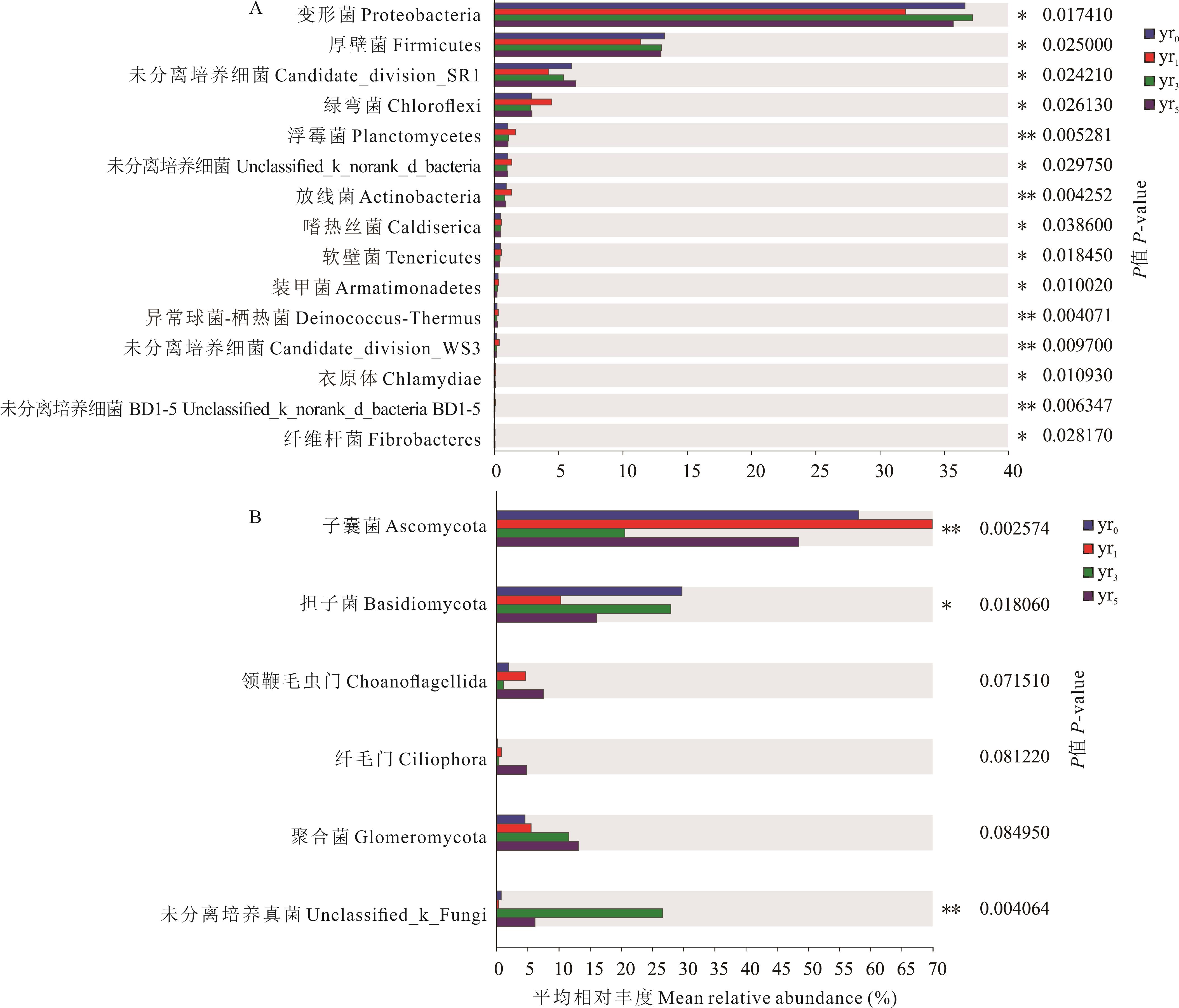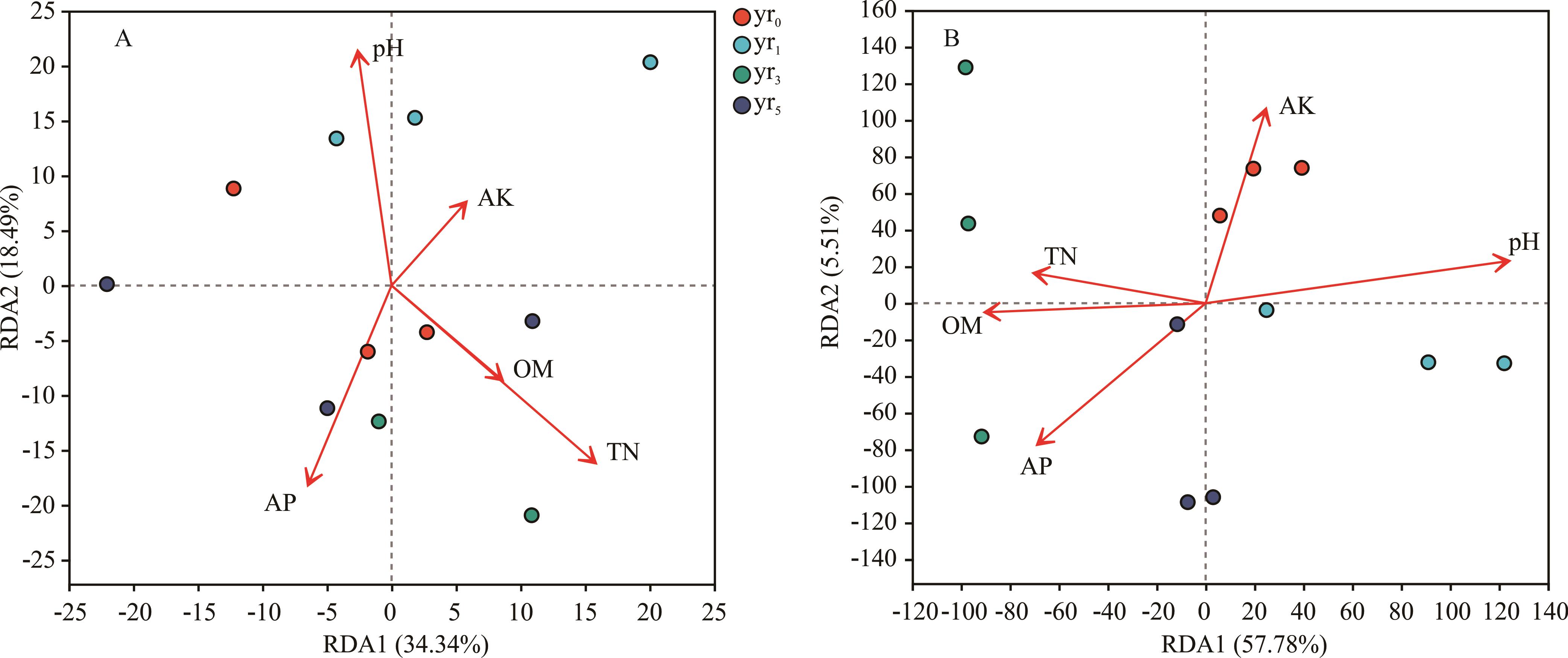

ISSN 1004-5759 CN 62-1105/S


草业学报 ›› 2024, Vol. 33 ›› Issue (9): 155-168.DOI: 10.11686/cyxb2023424
• 研究论文 • 上一篇
收稿日期:2023-11-14
修回日期:2024-01-18
出版日期:2024-09-20
发布日期:2024-06-20
通讯作者:
徐智明
作者简介:E-mail: xuzhiming821@163.com基金资助:
Zheng-yan LI( ), Zhi-ming XU(
), Zhi-ming XU( ), Yan LI, Yang LI
), Yan LI, Yang LI
Received:2023-11-14
Revised:2024-01-18
Online:2024-09-20
Published:2024-06-20
Contact:
Zhi-ming XU
摘要:
为了探究苜蓿连作对后作高丹草产量品质及土壤健康状况的影响,分别以撂荒地正茬种植高丹草(yr0)为对照、苜蓿1年龄(yr1)、3年龄(yr3)、5年龄(yr5)后轮作高丹草3种处理方式为研究对象,采用传统方法,试剂盒及高通量测序方法检测了轮作后高丹草的生长状况及产量差异、轮作后土壤化学性质、酶活性及微生物结构组成的变化,阐明了苜蓿短期连作对后作高丹草生长及产量的影响,从土壤微环境的角度评价了苜蓿连作对后作高丹草的影响。研究结果显示,与正茬高丹草相比(yr0),苜蓿轮作高丹草促进了后茬高丹草叶片数量及产量的增加,3年龄苜蓿(yr3)轮作高丹草与正茬(yr0)高丹草相比,后作高丹草产量增加了63.23%(P<0.05),粗蛋白及中性洗涤纤维含量也相应提高;后作高丹草土壤pH值随着前作苜蓿年龄的增加持续降低,土壤有机质、全氮含量持续增加,5年龄(yr5)苜蓿轮作高丹草后有机质含量比正茬高丹草(yr0)土壤增加了78.25%、全氮含量与正茬高丹草(yr0)土壤相比增加了34.88%(P<0.05);蔗糖酶活性在1年龄(yr1)苜蓿轮茬高丹草土壤中最高,脲酶在3年龄(yr3)后茬土壤中活性最高;在苜蓿轮作高丹草根际土壤中门水平优势细菌群落为变形菌、拟杆菌和厚壁菌,优势真菌群落为子囊菌、担子菌和聚合菌;前茬苜蓿3年龄(yr3)时轮作高丹草土壤细菌丰富度及多样性指数均为最高(P<0.05);前茬苜蓿5年龄(yr5)时轮作高丹草土壤真菌Shannon指数最高(P<0.05);苜蓿轮作高丹草土壤中的绿弯菌、浮霉菌、放线菌随着前作苜蓿年龄的增加呈先增加随后降低的变化趋势;相关性分析表明,土壤pH、有机质含量与土壤微生物结构关系紧密,苜蓿-高丹草轮作处理下,前作苜蓿分泌物和残体降解物进入土壤生态系统,加速特异微生物区系重构,缓解了土壤酸化及调整营养物质循环,具有改良土壤的作用,能够促产增效,但是种植年限不宜过久,种植年限超过3年后,土壤中的营养成分会打破平衡。该结果为江淮地区苜蓿连作障碍的生态修复,构建饲草可持续高效生产栽培关键技术体系提供了理论依据。
李争艳, 徐智明, 李岩, 李杨. 江淮地区苜蓿短期连作对后作高丹草生长及土壤微环境的影响[J]. 草业学报, 2024, 33(9): 155-168.
Zheng-yan LI, Zhi-ming XU, Yan LI, Yang LI. Effects of short-term continuous cropping of alfalfa on the growth and soil microenvironment of subsequent sorghum-sudan grass hybrid crops in the Jianghuai area[J]. Acta Prataculturae Sinica, 2024, 33(9): 155-168.
处理 Treatments | 缩写 Abbreviation | 处理描述 Description for treatments |
|---|---|---|
| 正茬高丹草Newly plant sorghum-sudan grass hybrid | yr0 | 2021年4月撂荒新地第一年种植高丹草,作为对照处理Planting sorghum-sudan grass hybrid in the first year of abandoned land as a control treatment in April 2021 |
| 1年龄苜蓿轮作高丹草1-year-old alfalfa rotated with sorghum-sudan grass hybrid | yr1 | 2020年4月种植苜蓿,前作苜蓿种植1年后于2021年4月轮作高丹草Alfalfa was planted in April 2020, and rotating sorghum-sudan grass hybrid the second year in April 2021 |
| 3年龄苜蓿轮作高丹草3-year-old alfalfa rotated with sorghum-sudan grass hybrid | yr3 | 2018年4月种植苜蓿,前作苜蓿种植3年后于2021年4月轮作高丹草Alfalfa was planted in April 2018, and rotating sorghum-sudan grass hybrid the fourth year in April 2021 |
| 5年龄苜蓿轮作高丹草5-year-old alfalfa rotated with sorghum-sudan grass hybrid | yr5 | 2016年4月种植苜蓿,前作苜蓿种植5年后于2021年4月轮作高丹草Alfalfa was planted in April 2016, and rotating sorghum-sudan grass hybrid the sixth year in April 2021 |
表1 不同处理详细描述
Table 1 Description of each treatment
处理 Treatments | 缩写 Abbreviation | 处理描述 Description for treatments |
|---|---|---|
| 正茬高丹草Newly plant sorghum-sudan grass hybrid | yr0 | 2021年4月撂荒新地第一年种植高丹草,作为对照处理Planting sorghum-sudan grass hybrid in the first year of abandoned land as a control treatment in April 2021 |
| 1年龄苜蓿轮作高丹草1-year-old alfalfa rotated with sorghum-sudan grass hybrid | yr1 | 2020年4月种植苜蓿,前作苜蓿种植1年后于2021年4月轮作高丹草Alfalfa was planted in April 2020, and rotating sorghum-sudan grass hybrid the second year in April 2021 |
| 3年龄苜蓿轮作高丹草3-year-old alfalfa rotated with sorghum-sudan grass hybrid | yr3 | 2018年4月种植苜蓿,前作苜蓿种植3年后于2021年4月轮作高丹草Alfalfa was planted in April 2018, and rotating sorghum-sudan grass hybrid the fourth year in April 2021 |
| 5年龄苜蓿轮作高丹草5-year-old alfalfa rotated with sorghum-sudan grass hybrid | yr5 | 2016年4月种植苜蓿,前作苜蓿种植5年后于2021年4月轮作高丹草Alfalfa was planted in April 2016, and rotating sorghum-sudan grass hybrid the sixth year in April 2021 |
产量、品质及生长指标 Yield, quality and growth indexes | 处理Treatments | |||
|---|---|---|---|---|
| yr0 | yr1 | yr3 | yr5 | |
| 酸性洗涤纤维Acid detergent fiber (g·kg-1 DM) | 32.49±0.87a | 34.24±1.95a | 33.45±0.89a | 32.77±2.16a |
| 中性洗涤纤维Neutral detergent fiber (g·kg-1 DM) | 55.18±0.83ab | 57.31±1.72a | 58.01±2.02a | 53.22±1.27b |
| 粗蛋白Crude protein (g·kg-1 DM) | 8.00±0.51b | 8.90±0.39ab | 9.21±0.18a | 8.34±0.40b |
| 粗灰分Crude ash (%) | 6.24±0.98a | 7.26±1.25a | 6.88±0.41a | 6.16±0.02a |
| 产量Yield (t·hm-2) | 94.17±12.85b | 149.34±36.95a | 153.70±20.17a | 136.49±11.86ab |
| 株高Plant height (cm) | 295.51±10.19a | 294.77±5.33a | 296.06±3.43a | 287.97±0.68a |
| 茎粗Stem diameter (cm) | 1.64±0.14a | 1.59±0.03a | 1.65±0.11a | 1.50±0.04a |
| 叶数Leaf number (Pieces) | 21.00±1.00b | 20.33±1.16b | 23.33±0.58a | 21.00±1.00b |
表2 不同轮作处理对后作高丹草营养成分及产量的影响
Table 2 Effects of different rotation treatments on the nutrient composition and yield of sorghum-sudan grass hybrid
产量、品质及生长指标 Yield, quality and growth indexes | 处理Treatments | |||
|---|---|---|---|---|
| yr0 | yr1 | yr3 | yr5 | |
| 酸性洗涤纤维Acid detergent fiber (g·kg-1 DM) | 32.49±0.87a | 34.24±1.95a | 33.45±0.89a | 32.77±2.16a |
| 中性洗涤纤维Neutral detergent fiber (g·kg-1 DM) | 55.18±0.83ab | 57.31±1.72a | 58.01±2.02a | 53.22±1.27b |
| 粗蛋白Crude protein (g·kg-1 DM) | 8.00±0.51b | 8.90±0.39ab | 9.21±0.18a | 8.34±0.40b |
| 粗灰分Crude ash (%) | 6.24±0.98a | 7.26±1.25a | 6.88±0.41a | 6.16±0.02a |
| 产量Yield (t·hm-2) | 94.17±12.85b | 149.34±36.95a | 153.70±20.17a | 136.49±11.86ab |
| 株高Plant height (cm) | 295.51±10.19a | 294.77±5.33a | 296.06±3.43a | 287.97±0.68a |
| 茎粗Stem diameter (cm) | 1.64±0.14a | 1.59±0.03a | 1.65±0.11a | 1.50±0.04a |
| 叶数Leaf number (Pieces) | 21.00±1.00b | 20.33±1.16b | 23.33±0.58a | 21.00±1.00b |
化学性质 Chemical properties | 处理Treatments | |||
|---|---|---|---|---|
| yr0 | yr1 | yr3 | yr5 | |
| pH | 8.15±0.06a | 8.08±0.03a | 7.91±0.05b | 7.88±0.05b |
| 有机质Organic matter (g·kg-1) | 12.83±1.35c | 18.33±0.91b | 19.90±1.71ab | 22.87±2.11a |
| 全氮Total nitrogen (g·kg-1) | 1.29±0.07b | 1.40±0.11b | 1.29±0.15b | 1.74±0.23a |
| 有效磷Available phosphorus (mg·kg-1) | 7.78±0.49a | 7.35±0.07a | 5.83±0.24a | 6.40±0.29a |
| 速效钾Available potassium (mg·kg-1) | 105.87±9.86c | 238.40±17.49b | 322.03±8.52a | 257.13±6.62b |
表3 不同轮作处理下土壤化学性质变化
Table 3 Changes of chemical characteristics of soil in different rotation treatments
化学性质 Chemical properties | 处理Treatments | |||
|---|---|---|---|---|
| yr0 | yr1 | yr3 | yr5 | |
| pH | 8.15±0.06a | 8.08±0.03a | 7.91±0.05b | 7.88±0.05b |
| 有机质Organic matter (g·kg-1) | 12.83±1.35c | 18.33±0.91b | 19.90±1.71ab | 22.87±2.11a |
| 全氮Total nitrogen (g·kg-1) | 1.29±0.07b | 1.40±0.11b | 1.29±0.15b | 1.74±0.23a |
| 有效磷Available phosphorus (mg·kg-1) | 7.78±0.49a | 7.35±0.07a | 5.83±0.24a | 6.40±0.29a |
| 速效钾Available potassium (mg·kg-1) | 105.87±9.86c | 238.40±17.49b | 322.03±8.52a | 257.13±6.62b |
土壤酶活性 Soil enzymes activity | 处理Treatments | |||
|---|---|---|---|---|
| yr0 | yr1 | yr3 | yr5 | |
| 碱性磷酸酶Alkaline phosphatase (μmol phenol·g-1·24 h-1) | 13.00±3.80a | 15.12±1.30a | 12.93±9.20a | 12.47±4.67a |
| 过氧化氢酶Catalase (μmol H2O2·g-1·24 h-1) | 176.76±7.40a | 174.77±1.75a | 178.25±1.09a | 177.43±4.33a |
| 蔗糖酶Sucrase (mg C6H12O6·g-1·24 h-1) | 28.74±2.34c | 46.53±3.09a | 39.65±5.46b | 43.25±2.17ab |
| 脲酶Urease (μg NH3-N·g-1·24 h-1) | 2268.89±215.18a | 1287.04±91.53b | 2298.37±424.21a | 1024.45±177.39b |
表4 不同轮作处理对土壤酶活性的影响
Table 4 Effects of different rotation treatments on soil enzyme activities
土壤酶活性 Soil enzymes activity | 处理Treatments | |||
|---|---|---|---|---|
| yr0 | yr1 | yr3 | yr5 | |
| 碱性磷酸酶Alkaline phosphatase (μmol phenol·g-1·24 h-1) | 13.00±3.80a | 15.12±1.30a | 12.93±9.20a | 12.47±4.67a |
| 过氧化氢酶Catalase (μmol H2O2·g-1·24 h-1) | 176.76±7.40a | 174.77±1.75a | 178.25±1.09a | 177.43±4.33a |
| 蔗糖酶Sucrase (mg C6H12O6·g-1·24 h-1) | 28.74±2.34c | 46.53±3.09a | 39.65±5.46b | 43.25±2.17ab |
| 脲酶Urease (μg NH3-N·g-1·24 h-1) | 2268.89±215.18a | 1287.04±91.53b | 2298.37±424.21a | 1024.45±177.39b |

图1 不同轮作处理的土壤样品细菌、真菌组成A:不同年龄苜蓿后作高丹草根部土壤中细菌平均相对丰度;B:不同年龄苜蓿后作高丹草根部土壤中真菌平均相对丰度。“Others”是所有相对丰度较低稀有细菌、真菌门的总和。 A: Average relative abundance of bacterial phyla in different soil samples of the subsequent sorghum-sudan grass hybrid rotated with alfalfa; B: Average relative abundance of fungal phyla in different soil samples of the subsequent sorghum-sudan grass hybrid rotated with alfalfa. “Others” are the sum of all rare bacterial fungal phyla with low relative abundances.
Fig.1 Soil bacteria and fungal community for different rotation treatments

图2 不同轮作处理对土壤细菌(A)、真菌(B)多样性的影响采用t检验评估OTU水平各样本的细菌、真菌多样性。Student’s t-test for estimator were used to estimate the bacterial and fungal diversity of each sample on OTU level. *: 0.01<P≤0.05; **: 0.001<P≤0.01; ***: P≤0.001. 下同The same below.
Fig.2 Soil bacteria (A) and fungal (B) diversity of different rotation treatments

图3 不同处理细菌(A)、真菌(B)相对丰度变化采用单因素方差分析(ANOVA)和Kruskal-Wallis H检验进行多重比较。One-way analysis of variance (ANOVA) and Kruskal-Wallis H test were used for multiple comparisons.
Fig.3 Different bacteria (A) and fungal (B) abundance based on phylum level

图4 细菌、真菌群落组成与土壤化学性质的冗余分析图中不同颜色的点表示不同年龄前茬苜蓿轮作高丹草的土壤样本组;图中微生物物种以蓝色箭头表示;箭头为数量型环境指标,箭头长短表明该环境指标对微生物物种的影响程度;环境因子箭头间的夹角代表正、负相关性,锐角表示正相关,钝角表示负相关,直角为不相关。The dots with different colors in the Figure represent soil samples of the subsequent sorghum-sudan grass hybrid rotated with alfalfa; The microbial species in the Figure are represented by blue arrows; The arrow represents a quantitative environmental indicator, and the length of the arrow indicates the degree of impact of the environmental indicator on microbial species; The angle between the arrows of environmental factors represents positive and negative correlation, acute angle represents positive correlation, obtuse angle represents negative correlation, and right angle represents uncorrelated.
Fig.4 Redundancy analyses (RDA) between bacterial/fungal community composition and soil chemical properties
| 1 | Wang L, Xie J, Luo Z, et al. Forage yield, water use efficiency, and soil fertility response to alfalfa growing age in the semiarid Loess Plateau of China. Agricultural Water Management, 2021, 243: 106415. |
| 2 | Fan Z L, Chai Q, Cao W D, et al.Ecosystem service function of green manure and its application in dryland agriculture of China.Chinese Journal of Applied Ecology, 2020, 31(4): 1389-1402. |
| 樊志龙, 柴强, 曹卫东, 等. 绿肥在我国旱地农业生态系统中的服务功能及其应用. 应用生态学报, 2020, 31(4): 1389-1402. | |
| 3 | Li Y, Huang M. Pasture yield and soil water depletion of continuous growing alfalfa in the Loess Plateau of China. Agriculture Ecosystems & Environment, 2008, 124(1): 24-32. |
| 4 | Basbuga S, Basbuga S, Yayla F, et al. Diversity of rhizobial and non-rhizobial bacteria nodulating wild ancestors of grain legume crop plants. International Microbiology, 2021, 24(2): 207-218. |
| 5 | Hegde R S, Miller D A. Allelopathy and autotoxicity in alfalfa: characterization and effects of preceding crops and residue incorporation. Crop Science, 1990, 30(6): 1255-1259. |
| 6 | Qin S H, Cao L, Zhang J L, et al. Effect of rotation of leguminous plants on soil available nutrients and physical and chemical properties in continuous cropping potato field. Acta Agronomica Sinica, 2014, 40(8): 1452-1458. |
| 秦舒浩, 曹莉, 张俊莲, 等. 轮作豆科植物对马铃薯连作田土壤速效养分及理化性质的影响. 作物学报, 2014, 40(8): 1452-1458. | |
| 7 | Wang L L, Xu G L, Feng Y H, et al. Effects of different winter planting patterns on soil physical properties and yield of succeeding hybrid rice. Journal of Mountain Agriculture and Biology, 2020, 39(5): 9-14. |
| 王玲莉, 许桂玲, 冯跃华, 等. 不同冬种模式对土壤物理性质和后茬杂交水稻产量的影响. 山地农业生物学报, 2020, 39(5): 9-14. | |
| 8 | Yang S. Feed analysis and feed quality testing technology. Beijing: Beijing Agricultural University Press, 1993: 89-108. |
| 杨胜. 饲料分析及饲料质量检测技术. 北京: 北京农业大学出版社, 1993: 89-108. | |
| 9 | Bao S D. Soil and agricultural chemistry analysis (The third edition). Beijing: China Agriculture Press, 2000: 106-108. |
| 鲍士旦. 土壤农化分析(第3版). 北京: 中国农业出版社, 2000: 106-108. | |
| 10 | Wu H M, Lin W X. A commentary and development perspective on the consecutive monoculture problems of medicinal plants. Chinese Journal of Eco-Agriculture, 2020, 28(6): 775-793. |
| 吴红淼, 林文雄. 药用植物连作障碍研究评述和发展透视. 中国生态农业学报, 2020, 28(6): 775-793. | |
| 11 | Lu M, Ren Y, Wang S, et al. Contribution of soil variables to bacterial community composition following land use change in Napahai plateau wetlands. Journal of Environmental Management, 2019, 246: 77-84. |
| 12 | Singh N, Singh G, Aggarwal N, et al. Yield enhancement and phosphorus economy in lentil (Lens culinaris Medikus) with integrated use of phosphorus, Rhizobium and plant growth promoting rhizobacteria. Journal of Plant Nutrition, 2018, 41(6): 737-748. |
| 13 | Farooq T H, Kumar U, Mo J, et al. Intercropping of peanut-tea enhances soil enzymatic activity and soil nutrient status at different soil profiles in subtropical southern China. Plants, 2021, 10(5): 881-897. |
| 14 | Xiao J, Chen S Y, Sun Y, et al. Effect of intercropping with different legume crops on endophytic bacterial diversity of sugarcanes. Chinese Journal of Tropical Crops, 2021, 42(11): 3188-3198. |
| 肖健, 陈思宇, 孙妍, 等. 甘蔗间作不同豆科作物对甘蔗植株内生细菌多样性的影响. 热带作物学报, 2021, 42(11): 3188-3198. | |
| 15 | Li H Y, Zhang Y H, Zhang Q, et al. Converting continuous cropping to rotation including subsoiling improves crop yield and prevents soil water deficit: A 12-yr in-situ study in the Loess Plateau, China. Agricultural Water Management, 2021, 256(1): 107062. |
| 16 | Hoyt P B, Hennig A M F. Effect of alfalfa and grasses on yield of subsequent wheat crops and some chemical properties of gray wooded soil. Canadian Journal of Soil Science, 1971, 51(2): 177-183. |
| 17 | Yang S H, Yang H S, Zhang Y Q, et al. The influence of alfalfa’s planted years on soil nutrients and the yield of subsequent maize. Chinese Agricultural Science Bulletin, 2012, 28(30): 131-134. |
| 杨升辉, 杨恒山, 张玉芹, 等. 苜蓿种植年限对土壤养分及后作玉米产量的影响. 中国农学通报, 2012, 28(30): 131-134. | |
| 18 | Zhang X L, Chen M T, Zhai P H, et al. Effects of water and fertilizer addition on photosynthetic rate and chlorophyll content of winter wheat leaves in alfalfa/winter wheat rotation system. Journal of Shanxi Agricultural University (Natural Science Edition), 2019, 39(4): 40-46. |
| 张晓琳, 陈梦恬, 翟鹏辉, 等. 增水和施肥对苜蓿-冬小麦轮作系统冬小麦叶片光合速率和叶绿素含量的影响. 山西农业大学学报(自然科学版), 2019, 39(4): 40-46. | |
| 19 | Sokolowski A C, Mccormick B P, Grazia J D, et al.Tillage and no-tillage effects on physical and chemical properties of an Argiaquoll soil under long-term crop rotation in Buenos Aires, Argentina. International Soil and Water Conservation Research, 2020, 8(2): 185-194. |
| 20 | Mikha M M, Hergert G W, Qiao X, et al. Soil chemical properties after 12 years of tillage and crop rotation. Agronomy Journal, 2020, 112(5): 4395-4406. |
| 21 | Solangi F, Bai J, Gao S, et al. Improved accumulation capabilities of phosphorus and potassium in green manures and its relationship with soil properties and enzymatic activities. Agronomy, 2019, 9(11): 708-723. |
| 22 | Chen W, Teng Y, Li Z A, et al. Mechanisms by which organic fertilizer and effective microbes mitigate peanut continuous cropping yield constraints in a red soil of south China. Applied Soil Ecology, 2018, 128: 23-34. |
| 23 | Lu J, Li W, Yang Y, et al. The impact of different rotation regime on the soil bacterial and fungal communities in an intensively managed agricultural region. Archives of Microbiology, 2022, 204(2): 142-154. |
| 24 | Liu Z X, Liu J J, Yu Z H, et al. Long-term continuous cropping of soybean is comparable to crop rotation in mediating microbial abundance, diversity and community composition. Soil and Tillage Research, 2020, 197: 104503. |
| 25 | Hartz T K, Smith R, Gaskell M. Nitrogen availability from liquid organic fertilizers. Hort Technology, 2010, 20(1): 169-172. |
| 26 | Liu N, Shao C, Sun H, et al. Arbuscular mycorrhizal fungi biofertilizer improves American ginseng (Panax quinquefolius L.) growth under the continuous cropping regime. Geoderma, 2020, 363: 114155. |
| 27 | Song X H, Tan J, Li L Y, et al. Illumina high-throughput sequencing reveals fungal community composition and diversity in root rot of Coptis chinensis in rhizosphere soil. Chinese Traditional and Herbal Drugs, 2018, 49(22): 5396-5403. |
| 宋旭红, 谭均, 李隆云, 等. Illumina高通量测序揭示黄连根腐根际土壤真菌群落组成及多样性. 中草药, 2018, 49(22): 5396-5403. | |
| 28 | Liu J, Chen X F, Liu M, et al. Effects of long-term fertilization on bacterial community in upland red soil. Acta Pedologica Sinica, 2020, 57(2): 468-478. |
| 刘佳, 陈晓芬, 刘明, 等. 长期施肥对旱地红壤细菌群落的影响. 土壤学报, 2020, 57(2): 468-478. | |
| 29 | Ding Y P, Du Y J, Gao G L, et al. Soil bacterial community structure and functional prediction of Pinus sylvestris var. mongolica plantations in the Hulun Buir sandy land. Acta Ecologica Sinica, 2021, 41(10): 4131-4139. |
| 丁钰珮, 杜宇佳, 高广磊, 等. 呼伦贝尔沙地樟子松人工林土壤细菌群落结构与功能预测. 生态学报, 2021, 41(10): 4131-4139. | |
| 30 | Hallama M, Pekrun C, Lambers H, et al. Hidden miners-the roles of cover crops and soil microorganisms in phosphorus cycling through agroecosystems. Plant and Soil, 2019, 434: 7-45. |
| 31 | Wang D, Li T, Huang K, et al. Roles and correlations of functional bacteria and genes in the start-up of simultaneous anammox and denitrification system for enhanced nitrogen removal. Science of the Total Environment, 2019, 655: 1355-1363. |
| 32 | Wang J P, Huang R Z, Zhu L Q, et al. Effects of different fertility improvement measures on microbial community structures in biological red soil crusts of woodland. Acta Pedologica Sinica, 2023, 60(1): 292-303. |
| 王金平, 黄荣珍, 朱丽琴, 等. 肥力提升措施对林地红壤生物结皮层微生物群落结构的影响. 土壤学报, 2023, 60(1): 292-303. | |
| 33 | Ortiz C, Fernández-Alonso M J, Kitzler B, et al. Variations in soil aggregation, microbial community structure and soil organic matter cycling associated to long-term afforestation and woody encroachment in a Mediterranean alpine ecotone. Geoderma, 2022, 405: 115450. |
| 34 | Zhou L Z, Lao C Y, Shen Z Y, et al. Analysis of diversity of rhizosphere soil bacterial community of yam in directional cultivation in continuous cropping. Southwest China Journal of Agricultural Sciences, 2021, 34(8): 1601-1607. |
| 周灵芝, 劳承英, 申章佑, 等. 定向栽培连作淮山根际土壤细菌群落的多样性分析. 西南农业学报, 2021, 34(8): 1601-1607. | |
| 35 | Tawaraya K. Response of mycorrhizal symbiosis to phosphorus and its application for sustainable crop production and remediation of environment. Soil Science and Plant Nutrition, 2022, 68(2): 241-245. |
| 36 | Li F F, Sun A Q, Jiao X Y, et al. Specific protistan consumers and parasites are responsive to inorganic fertilization in rhizosphere and bulk soils. Journal of Soils and Sediments, 2021, 21: 3801-3812. |
| 37 | Pishgar R, John A S, Zhi Y T, et al. Denitrification performance and microbial versatility in response to different selection pressures. Bioresource Technology, 2019, 281: 72-83. |
| [1] | 吕自立, 刘彬, 常凤, 马紫荆, 曹秋梅. 巴音布鲁克高寒草甸物种多样性与系统发育多样性沿海拔梯度分布格局及驱动因子[J]. 草业学报, 2023, 32(7): 12-22. |
| [2] | 汪精海, 李广, 银敏华, 齐广平, 康燕霞, 马彦麟. 调亏灌溉对高寒荒漠区人工混播草地土壤环境与牧草生长的影响[J]. 草业学报, 2022, 31(1): 95-106. |
| [3] | 刘晶, 赵燕, 张巧明, 徐少君. 不同利用方式对豫西黄土丘陵区土壤微生物生物量及群落结构特征的影响[J]. 草业学报, 2016, 25(8): 36-47. |
| [4] | 张莉,王长庭,刘伟,王启兰,李里,向泽宇. 不同建植期人工草地优势种植物根系活力、群落特征及其土壤环境的关系[J]. 草业学报, 2012, 21(5): 185-194. |
| 阅读次数 | ||||||
|
全文 |
|
|||||
|
摘要 |
|
|||||